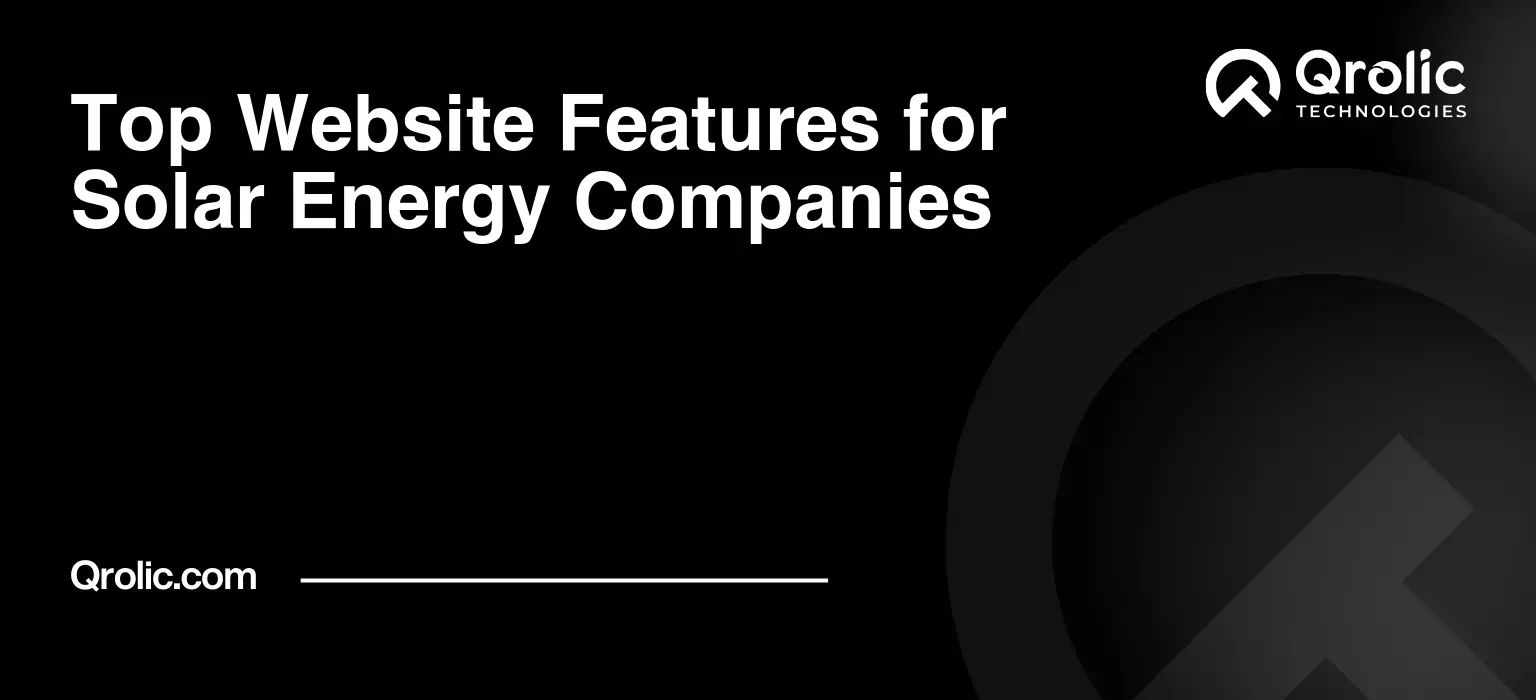Quick Summary:
- Make your website inviting and simple to use.
- Provide tools to explore solar and get quotes.
- Offer clear info and build local credibility.
Table of Contents
- 1. Captivating First Impressions: The Homepage as Your Digital Solar Salesperson
- 1.1. Above-the-Fold Power: Hooking Visitors Instantly
- 1.2. Showcasing Social Proof: Building Trust and Credibility
- 1.3. Intuitive Navigation: Guiding Visitors to Key Information
- 2. Product Showcase: Highlighting Your Solar Solutions
- 2.1. Detailed Product Pages: Answering Every Question
- 2.2. Virtual Solar System Design Tools: Empowering Customers
- 2.3. Solar Panel Comparison Charts: Simplify the Decision-Making Process
- 3. Installation Inquiry: Streamlining the Sales Process
- 3.1. Easy-to-Use Contact Forms: Capture Leads Effectively
- 3.2. Online Appointment Scheduling: Convenience for Customers
- 3.3. Interactive Site Assessment Tools: Gather Key Information Upfront
- 3.4. Chatbots: Instant Answers and Lead Qualification
- 4. Educational Resources: Becoming a Trusted Solar Authority
- 4.1. Blog: Informative and Engaging Content
- 4.2. FAQ Section: Addressing Common Concerns
- 4.3. Solar Glossary: Demystifying Technical Terms
- 4.4. Calculators and Tools: Empowering Informed Decisions
- 5. Financing Options: Making Solar Affordable
- 5.1. Clear Explanation of Financing Options
- 5.2. Partnerships with Financing Providers
- 5.3. Transparency and Education
- 6. About Us: Building Trust and Authority
- 6.1. Company History and Mission
- 6.2. Team Profiles: Putting Faces to the Name
- 6.3. Awards and Recognition
- 7. Local SEO: Reaching Your Target Market
- 7.1. Google My Business Optimization
- 7.2. Local Keyword Targeting
- 7.3. Local Citations
- 8. Website Security and Performance
- 8.1. SSL Certificate: Secure Your Website
- 8.2. Website Speed Optimization
- 8.3. Mobile Optimization
- 9. Accessibility: Ensuring Inclusivity
- 9.1. Alt Text for Images
- 9.2. Keyboard Navigation
- 9.3. Color Contrast
- 10. Analytics and Tracking: Measuring Success
- 10.1. Google Analytics Integration
- 10.2. Call Tracking
- 10.3. Heatmaps and User Recordings
- 11. Qrolic Technologies: Your Partner in Solar Website Excellence
- 12. Future-Proofing Your Solar Website: Staying Ahead of the Curve
- 12.1. Embracing Emerging Technologies
- 12.2. Adapting to Changing Consumer Behavior
- 12.3. Continuous Improvement and Innovation
1. Captivating First Impressions: The Homepage as Your Digital Solar Salesperson
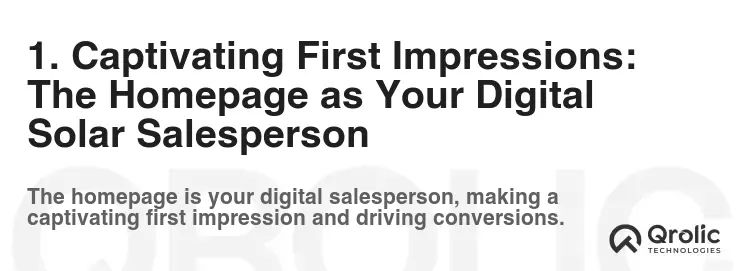
1.1. Above-the-Fold Power: Hooking Visitors Instantly
The area “above the fold” – what visitors see without scrolling – is prime real estate. This is where you make your first, and potentially most important, impression. Think of it as the curb appeal for your online solar business.
- Compelling Headline: Ditch generic phrases like “Solar Solutions.” Instead, use benefit-driven headlines that speak directly to customer pain points and desires. Examples:
- “Slash Your Energy Bills by Up to 80% with Solar Power”
- “Go Green, Save Green: Sustainable Energy for a Brighter Future”
- “Unlock Energy Independence with a Custom Solar System”
- High-Quality Visuals: Invest in professional photography or videography that showcases solar panels on homes, happy families benefiting from solar, or visually stunning images of sustainable energy solutions. Avoid stock photos that look generic or staged. Focus on authentic images that build trust. Show the “before” (high energy bills) and “after” (peace of mind with solar).
- Clear Call to Action (CTA): Don’t leave visitors wondering what to do next. Prominent CTAs guide them towards the next step. Use action-oriented language:
- “Get a Free Solar Quote”
- “Calculate Your Savings”
- “Explore Solar Options”
- “Contact Us Today”
- Make these buttons visually appealing and easy to click on any device (desktop, tablet, mobile).
1.2. Showcasing Social Proof: Building Trust and Credibility
- Customer Testimonials: Real stories from satisfied customers are incredibly powerful. Feature testimonials prominently on your homepage, ideally with photos or videos. Focus on specific benefits they experienced: reduced energy bills, increased home value, environmental impact.
- Case Studies: Go deeper than testimonials. Present detailed case studies showcasing successful solar installations. Include data points like energy savings, system size, and customer feedback.
- Industry Recognition & Awards: Display any awards, certifications, or affiliations that demonstrate your expertise and credibility in the solar industry. Logos of reputable organizations like the Solar Energy Industries Association (SEIA) can boost trust.
- Numbers Speak Volumes: Quantify your impact with statistics: “Installed over 1,000 solar systems,” “Saved customers over $5 million in energy costs,” “Reduced carbon emissions by X tons.”
1.3. Intuitive Navigation: Guiding Visitors to Key Information
- Clear and Concise Menu: Your website menu should be easy to understand and navigate. Use clear labels like “Residential Solar,” “Commercial Solar,” “About Us,” “Services,” “Financing,” and “Contact.”
- Dropdown Menus (Use Sparingly): If you have many pages, use dropdown menus to organize them logically. But avoid overwhelming users with too many options.
- Search Functionality: Implement a robust search function that allows visitors to quickly find specific information on your website.
- Mobile-First Design: Ensure your website is fully responsive and looks great on all devices, especially smartphones. A large percentage of your visitors will likely be using mobile devices.
2. Product Showcase: Highlighting Your Solar Solutions
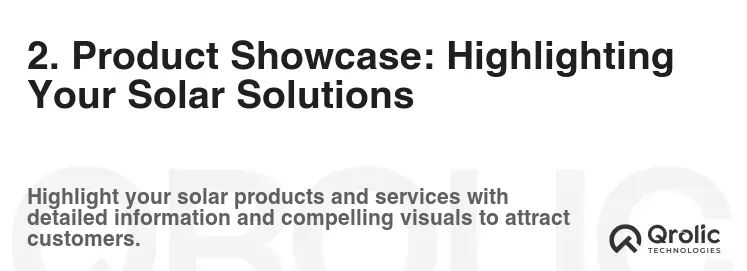
2.1. Detailed Product Pages: Answering Every Question
- Comprehensive Product Descriptions: Provide detailed information about each solar panel, inverter, battery, and other components you offer. Include specifications, warranties, and performance data. Use technical terms correctly but explain them in plain language for non-technical users.
- High-Quality Images & Videos: Showcase your products with high-resolution images from multiple angles. Include videos that demonstrate product features and benefits. Consider 360-degree views for enhanced engagement.
- Interactive Product Configurators: Allow visitors to customize their solar system based on their specific needs and energy consumption. This adds a level of personalization and engagement.
- Datasheets and Technical Specifications: Provide downloadable datasheets for each product. This allows customers to review detailed technical specifications offline.
- Warranty Information: Clearly state the warranty terms for each product. This builds trust and reassures customers about the long-term reliability of your products.
- Integration with Rebate and Incentive Information: Display available rebates, tax credits, and incentives for each product. This can significantly impact the affordability of solar and make it more attractive to potential customers.
2.2. Virtual Solar System Design Tools: Empowering Customers
- Address Input: Allow users to enter their address to see a satellite view of their roof and estimate solar potential.
- Roof Measurement Tools: Integrate tools that allow users to measure their roof dimensions and calculate the available space for solar panels.
- Panel Placement Simulation: Enable users to simulate the placement of solar panels on their roof and see how they would look.
- Energy Production Estimates: Provide estimates of the amount of energy the solar system will generate based on their location, roof orientation, and panel specifications.
- Cost Savings Calculator: Allow users to calculate the estimated cost savings based on their energy consumption and solar system output.
- Integration with Financing Options: Seamlessly integrate financing options into the design tool so users can explore different payment plans.
2.3. Solar Panel Comparison Charts: Simplify the Decision-Making Process
- Side-by-Side Comparison: Create comparison charts that allow users to compare different solar panels based on key features like efficiency, warranty, price, and power output.
- Filtering and Sorting: Allow users to filter and sort the panels based on their specific needs and preferences.
- Clear Visualizations: Use clear and concise visualizations to highlight the differences between the panels.
- Explanation of Key Metrics: Provide clear explanations of key metrics like efficiency, temperature coefficient, and power tolerance.
3. Installation Inquiry: Streamlining the Sales Process
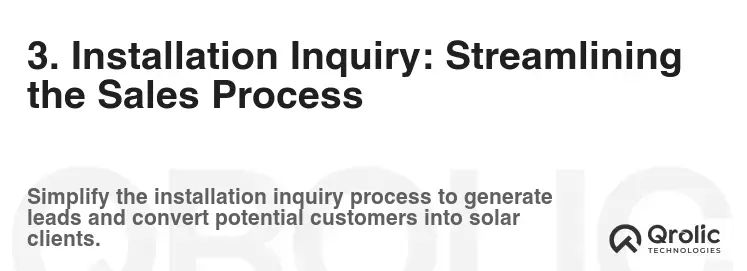
3.1. Easy-to-Use Contact Forms: Capture Leads Effectively
- Minimal Form Fields: Keep contact forms short and easy to fill out. Only ask for essential information like name, email, phone number, and address.
- Clear Call to Action: Use a clear and compelling CTA on the submit button, such as “Get a Free Quote” or “Schedule a Consultation.”
- Mobile-Friendly Forms: Ensure your contact forms are fully responsive and easy to fill out on mobile devices.
- Spam Protection: Implement spam protection measures to prevent bot submissions.
- Confirmation Message: Display a confirmation message after the form is submitted to let users know their inquiry has been received.
3.2. Online Appointment Scheduling: Convenience for Customers
- Calendar Integration: Integrate with a calendar system like Google Calendar or Outlook to allow users to easily schedule appointments online.
- Multiple Appointment Types: Offer different appointment types, such as free consultations, site assessments, and installation appointments.
- Automated Reminders: Send automated email and SMS reminders to users before their scheduled appointments.
- Time Zone Support: Ensure your appointment scheduling system supports different time zones.
3.3. Interactive Site Assessment Tools: Gather Key Information Upfront
- Address Verification: Verify the user’s address to ensure accurate location data.
- Roof Image Upload: Allow users to upload photos of their roof to provide a visual assessment.
- Energy Bill Upload: Request a copy of the user’s energy bill to estimate their energy consumption.
- Questionnaire about Energy Needs: Ask questions about the user’s energy usage habits, such as appliance usage and occupancy patterns.
3.4. Chatbots: Instant Answers and Lead Qualification
- 24/7 Availability: Provide instant answers to common questions 24/7.
- Lead Qualification: Qualify leads by asking questions about their needs and budget.
- Personalized Recommendations: Provide personalized recommendations based on the user’s answers.
- Seamless Hand-Off to Human Agents: Seamlessly hand off the conversation to a human agent when necessary.
4. Educational Resources: Becoming a Trusted Solar Authority

4.1. Blog: Informative and Engaging Content
- Keyword Research: Conduct thorough keyword research to identify topics that are relevant to your target audience.
- High-Quality Content: Create informative and engaging blog posts that answer common questions about solar energy.
- Variety of Content Formats: Use a variety of content formats, such as articles, infographics, videos, and case studies.
- Regular Updates: Update your blog regularly with fresh content.
- SEO Optimization: Optimize your blog posts for search engines.
4.2. FAQ Section: Addressing Common Concerns
- Comprehensive List of Questions: Compile a comprehensive list of frequently asked questions about solar energy.
- Clear and Concise Answers: Provide clear and concise answers to each question.
- Categorize Questions: Categorize the questions by topic for easy navigation.
- SEO Optimization: Optimize the FAQ section for search engines.
4.3. Solar Glossary: Demystifying Technical Terms
- Definition of Technical Terms: Define key technical terms related to solar energy.
- Plain Language Explanations: Explain the terms in plain language that is easy to understand.
- Alphabetical Order: Organize the terms in alphabetical order for easy reference.
4.4. Calculators and Tools: Empowering Informed Decisions
- Savings Calculator: Allow users to calculate their potential savings with solar energy.
- Payback Period Calculator: Calculate the estimated payback period for a solar system.
- System Size Calculator: Help users determine the appropriate size for their solar system.
5. Financing Options: Making Solar Affordable
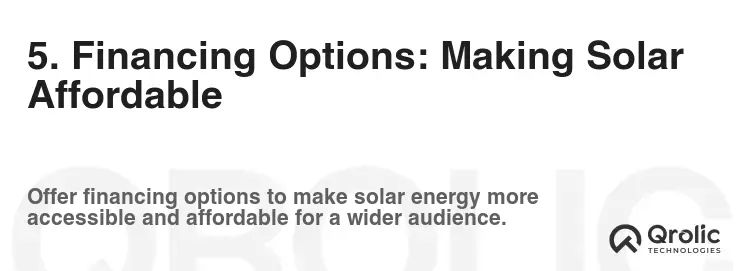
5.1. Clear Explanation of Financing Options
- Loan Options: Explain different loan options, such as secured loans and unsecured loans.
- Lease Options: Explain solar lease options and their benefits and drawbacks.
- Power Purchase Agreements (PPAs): Explain PPAs and how they work.
- Government Incentives: Detail available government incentives, such as tax credits and rebates.
5.2. Partnerships with Financing Providers
- Preferred Lender Program: Partner with reputable financing providers to offer preferred rates to your customers.
- Seamless Integration: Integrate financing options seamlessly into your website.
- Pre-Approval Process: Allow users to get pre-approved for financing online.
5.3. Transparency and Education
- Informative Content: Provide informative content about the different financing options.
- Comparison Charts: Create comparison charts that highlight the key differences between the options.
- Financial Calculators: Offer financial calculators to help users estimate their monthly payments and overall costs.
6. About Us: Building Trust and Authority
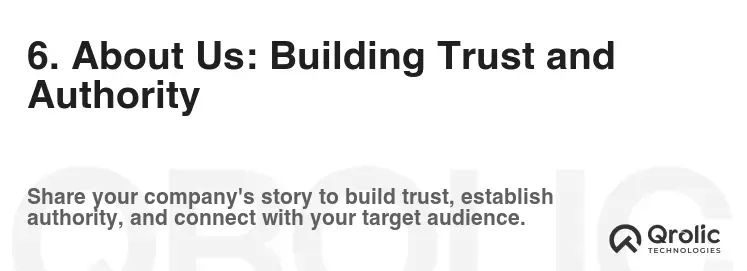
6.1. Company History and Mission
- Share Your Story: Tell the story of your company’s founding and mission.
- Highlight Your Values: Emphasize your company’s values, such as sustainability, customer service, and innovation.
- Build Trust: Establish your company as a trusted and reliable provider of solar energy solutions.
6.2. Team Profiles: Putting Faces to the Name
- Introduce Your Team: Introduce your team members and their expertise.
- Professional Photos: Use professional photos of your team members.
- Biographies: Provide brief biographies highlighting their experience and qualifications.
- Humanize Your Company: Humanize your company and build relationships with potential customers.
6.3. Awards and Recognition
- Showcase Your Achievements: Display any awards or recognition your company has received.
- Build Credibility: Demonstrate your company’s expertise and commitment to quality.
7. Local SEO: Reaching Your Target Market
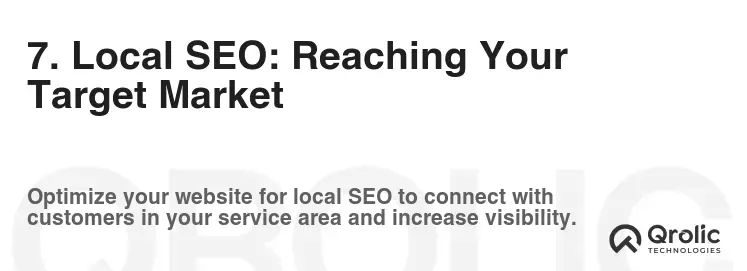
7.1. Google My Business Optimization
- Claim Your Listing: Claim and verify your Google My Business listing.
- Complete Profile: Complete your profile with accurate information, including your business name, address, phone number, website, and hours of operation.
- High-Quality Photos: Upload high-quality photos of your business, including your office, team, and solar installations.
- Customer Reviews: Encourage customers to leave reviews on your Google My Business listing.
- Respond to Reviews: Respond to customer reviews, both positive and negative.
7.2. Local Keyword Targeting
- Identify Local Keywords: Identify local keywords that your target audience is using to search for solar energy solutions.
- Optimize Your Website: Optimize your website with these local keywords, including your title tags, meta descriptions, and content.
- Create Location Pages: Create separate location pages for each of your service areas.
7.3. Local Citations
- Build Citations: Build local citations on reputable online directories, such as Yelp, Yellow Pages, and Angie’s List.
- NAP Consistency: Ensure your NAP (Name, Address, Phone Number) information is consistent across all citations.
8. Website Security and Performance

8.1. SSL Certificate: Secure Your Website
- HTTPS Protocol: Install an SSL certificate to enable HTTPS protocol.
- Data Encryption: Encrypt data transmitted between your website and users’ browsers.
- Build Trust: Build trust with your visitors by showing them that your website is secure.
8.2. Website Speed Optimization
- Fast Loading Times: Optimize your website for fast loading times.
- Image Optimization: Compress and optimize images to reduce file size.
- Caching: Implement caching to improve website performance.
- Content Delivery Network (CDN): Use a CDN to distribute your website’s content across multiple servers.
8.3. Mobile Optimization
- Responsive Design: Use a responsive design that adapts to different screen sizes.
- Mobile-Friendly Navigation: Ensure your website has a mobile-friendly navigation system.
- Touch-Friendly Elements: Use touch-friendly elements, such as large buttons and links.
9. Accessibility: Ensuring Inclusivity
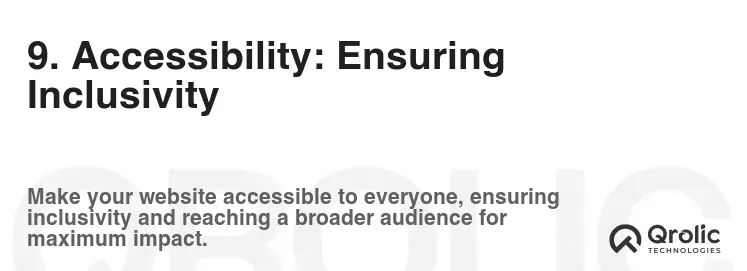
9.1. Alt Text for Images
- Descriptive Alt Text: Add descriptive alt text to all images on your website.
- Accessibility for Visually Impaired: Provide alternative text for visually impaired users.
9.2. Keyboard Navigation
- Keyboard Accessibility: Ensure your website can be navigated using the keyboard.
- Tab Order: Define a logical tab order for keyboard navigation.
9.3. Color Contrast
- Sufficient Color Contrast: Use sufficient color contrast between text and background colors.
- Accessibility for Color Blind Users: Consider the needs of color blind users when choosing colors.
10. Analytics and Tracking: Measuring Success
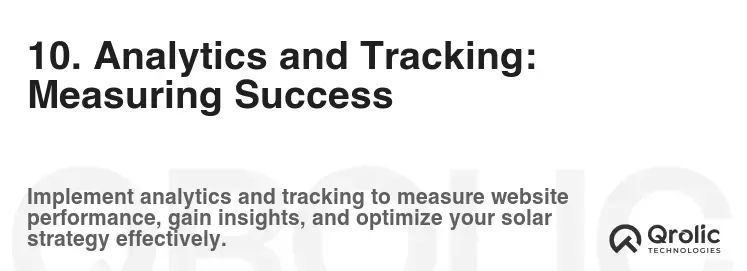
10.1. Google Analytics Integration
- Track Website Traffic: Integrate Google Analytics to track website traffic, user behavior, and conversions.
- Set Goals: Set goals to track key performance indicators (KPIs), such as leads generated and sales closed.
- Analyze Data: Analyze the data to identify areas for improvement.
10.2. Call Tracking
- Track Phone Calls: Implement call tracking to track phone calls generated from your website.
- Attribute Conversions: Attribute conversions to specific marketing campaigns.
10.3. Heatmaps and User Recordings
- User Behavior Analysis: Use heatmaps and user recordings to analyze user behavior on your website.
- Identify Areas for Improvement: Identify areas where users are getting stuck or confused.
11. Qrolic Technologies: Your Partner in Solar Website Excellence

Qrolic Technologies (https://qrolic.com/) understands the unique challenges and opportunities that solar energy companies face in the digital landscape. We specialize in creating high-performing websites that attract qualified leads, showcase your expertise, and drive sales.
How Qrolic Technologies Can Help Your Solar Business:
- Custom Website Design & Development: We create visually stunning and user-friendly websites tailored to your brand and target audience.
- SEO Optimization: We implement proven SEO strategies to ensure your website ranks high in search engine results, driving organic traffic and increasing visibility.
- Lead Generation Solutions: We develop effective lead generation strategies that capture qualified leads and nurture them through the sales funnel.
- E-commerce Integration: We integrate e-commerce functionality to allow you to sell solar products and services online.
- Content Marketing: We create engaging and informative content that educates your audience and establishes you as a trusted solar authority.
- Ongoing Website Maintenance & Support: We provide ongoing website maintenance and support to ensure your website is always up-to-date and performing optimally.
Why Choose Qrolic Technologies?
- Industry Expertise: We have a deep understanding of the solar energy industry and its unique needs.
- Results-Driven Approach: We are committed to delivering measurable results and helping you achieve your business goals.
- Customer-Focused Service: We provide personalized and responsive customer service.
- Competitive Pricing: We offer competitive pricing without compromising on quality.
Ready to take your solar business to the next level? Contact Qrolic Technologies today for a free consultation.
12. Future-Proofing Your Solar Website: Staying Ahead of the Curve
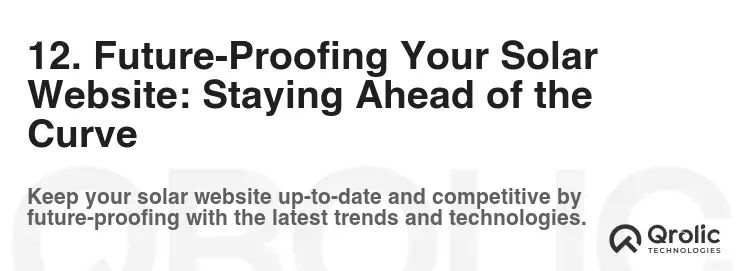
12.1. Embracing Emerging Technologies
- Artificial Intelligence (AI): Explore the use of AI-powered chatbots, personalized recommendations, and predictive analytics.
- Augmented Reality (AR): Consider incorporating AR features to allow users to visualize solar panels on their homes.
- Blockchain Technology: Investigate the potential of blockchain technology for energy trading and peer-to-peer solar energy sharing.
12.2. Adapting to Changing Consumer Behavior
- Mobile-First Indexing: Ensure your website is fully optimized for mobile devices to comply with Google’s mobile-first indexing.
- Voice Search Optimization: Optimize your website for voice search by using natural language and long-tail keywords.
- Personalized User Experiences: Deliver personalized user experiences based on user data and preferences.
12.3. Continuous Improvement and Innovation
- Regular Website Audits: Conduct regular website audits to identify areas for improvement.
- Stay Up-to-Date with Industry Trends: Stay up-to-date with the latest trends in solar energy and website design.
- Experiment with New Technologies: Experiment with new technologies and features to stay ahead of the competition.
By implementing these top website features, solar energy companies can create a powerful online presence that attracts qualified leads, showcases their expertise, and drives sales. Remember to focus on providing valuable information, creating a user-friendly experience, and continuously improving your website to meet the evolving needs of your target audience.
